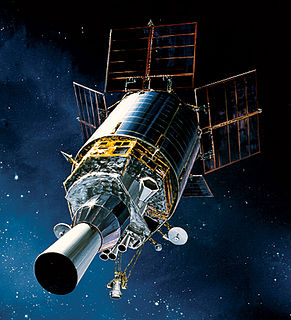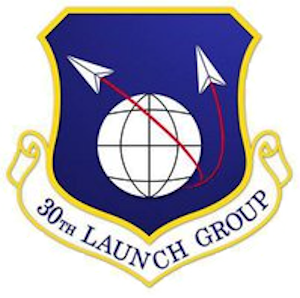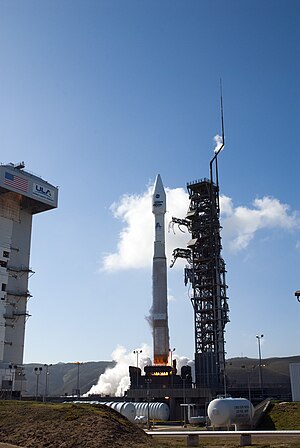
Titan was a family of United States expendable rockets used between 1959 and 2005. The Titan I and Titan II were part of the US Air Force's intercontinental ballistic missile (ICBM) fleet until 1987. The space launch vehicle versions contributed the majority of the 368 Titan launches, including all the Project Gemini crewed flights of the mid-1960s. Titan vehicles were also used to lift US military payloads as well as civilian agency reconnaissance satellites and to send interplanetary scientific probes throughout the Solar System.
The SM-65 Atlas was the first operational intercontinental ballistic missile (ICBM) developed by the United States and the first member of the Atlas rocket family. It was built for the U.S. Air Force by the Convair Division of General Dynamics at an assembly plant located in Kearny Mesa, San Diego. Atlas became operational in October 1959, but was soon made obsolete as an ICBM by new development, and was retired from this role by 1965.

Vandenberg Space Force Base, previously Vandenberg Air Force Base, is a United States Space Force Base located 14.8 km (9.2 mi) northwest of Lompoc, California. Established in 1941, Vandenberg Space Force Base is a space launch base, launching spacecraft from the Western Range, and also performs missile testing. The United States Space Force's Space Launch Delta 30 serves as the host delta for the base. In addition to its military space launch mission, Vandenberg Space Force Base also performs space launches for civil and commercial space entities, such as NASA and SpaceX.

Delta IV is a group of five expendable launch systems in the Delta rocket family introduced in the early 2000s. Originally designed by Boeing's Defense, Space and Security division for the Evolved Expendable Launch Vehicle (EELV) program, the Delta IV became a United Launch Alliance (ULA) product in 2006. The Delta IV is primarily a launch vehicle for United States Air Force (USAF) military payloads, but has also been used to launch a number of United States government non-military payloads and a single commercial satellite.

National Security Space Launch (NSSL) — formerly Evolved Expendable Launch Vehicle (EELV) from 1994 to 2019 — is a program of the United States Space Force (USSF) intended to assure access to space for United States Department of Defense and other United States government payloads. The program is managed by the Space Force's Space and Missile Systems Center SMC, specifically the SMC's Launch Enterprise Systems Directorate, in partnership with the National Reconnaissance Office.

Titan IV was a family of heavy-lift space launch vehicles developed by Martin Marietta and operated by the United States Air Force from 1989 to 2005. Launches were conducted from Cape Canaveral Air Force Station, Florida and Vandenberg Air Force Base, California.

The Titan IIIC was an expendable launch system used by the United States Air Force from 1965 until 1982. It was the first Titan booster to feature large solid rocket motors and was planned to be used as a launcher for the Dyna-Soar, though the spaceplane was cancelled before it could fly. The majority of the launcher's payloads were DoD satellites, for military communications and early warning, though one flight (ATS-6) was performed by NASA. The Titan IIIC was launched exclusively from Cape Canaveral while its sibling, the Titan IIID, was launched only from Vandenberg AFB.

Atlas II was a member of the Atlas family of launch vehicles, which evolved from the successful Atlas missile program of the 1950s. It was designed to launch payloads into low earth orbit, geosynchronous transfer orbit or geosynchronous orbit. Sixty-three launches of the Atlas II, IIA and IIAS models were carried out between 1991 and 2004; all sixty-three launches were successes, making the Atlas II the most reliable launch system in history. The Atlas line was continued by the Atlas III, used between 2000 and 2005, and the Atlas V which is still in use.

The Defense Support Program (DSP) is a program of the United States Space Force that operated the reconnaissance satellites which form the principal component of the Satellite Early Warning System used by the United States.

Milstar is a constellation of military communications satellites in geosynchronous orbit, which are operated by the United States Space Force, and provide secure and jam-resistant worldwide communications to meet the requirements of the Armed Forces of the United States. Six spacecraft were launched between 1994 and 2003, of which five are currently operational; the third launch failed, both damaging the satellite and leaving it in an unusable orbit.

Space Launch Complex 6 at Vandenberg Space Force Base in California is a launch pad and support area. The site was originally developed for Titan III rockets and the Manned Orbiting Laboratory, but these were cancelled before construction of SLC-6 was complete. The complex was later rebuilt to serve as the west coast launch site for the Space Shuttle, but went unused due to budget, safety and political considerations. The pad was subsequently used for several Athena rocket launches before being modified to support the Delta IV launch vehicle family, which have used the pad since 2006.

Space Systems Command (SSC) is the United States Space Force's space development, acquisition, launch, and logistics field command. It is headquartered at Los Angeles Air Force Base, California and manages the United States' space launch ranges.

The United States Space Force's 5th Space Launch Squadron is a space launch unit located at Patrick Space Force Base, Florida. The 5th SLS is tasked with launch and support of the Evolved Expendable Launch Vehicles.

The Delta IV Heavy is an expendable heavy-lift launch vehicle, the largest type of the Delta IV family. It is the world's second highest-capacity launch vehicle in operation, behind SpaceX's Falcon Heavy, and closely followed by CNSA's Long March 5. It is manufactured by United Launch Alliance and was first launched in 2004.

The 2nd Space Launch Squadron is an active United States Space Force unit. It is located at Vandenberg Space Force Base, California, and was reactivated in July 2019 with the merger of the 4th Space Launch Squadron and the 1st Air and Space Test Squadron.

The 30th Operations Group was a group of the United States Space Force. It was assigned to the 30th Space Wing, stationed at Vandenberg Air Force Base, California. It was responsible for all space launch operations from the West Coast of the United States, including all polar launches. It operated the Western Range, which conducts launches for the Space Force, other parts of the Department of Defense, NASA, and private space corporations. In 2021 the 30th Operations Group and the 30th Mission Support Group were inactivated and squadrons assigned to Space Launch Delta 30.

The 6555th Aerospace Test Group is an inactive United States Air Force unit. It was last assigned to the Eastern Space and Missile Center and stationed at Patrick Air Force Base, Florida. It was inactivated on 1 October 1990.

The 45th Launch Group is a United States Air Force unit. It is assigned to the 45th Space Wing, stationed at Cape Canaveral Air Force Station, Florida.

The 30th Launch Group was a United States Air Force unit, and was assigned to the 30th Space Wing, Vandenberg AFB, California.




















